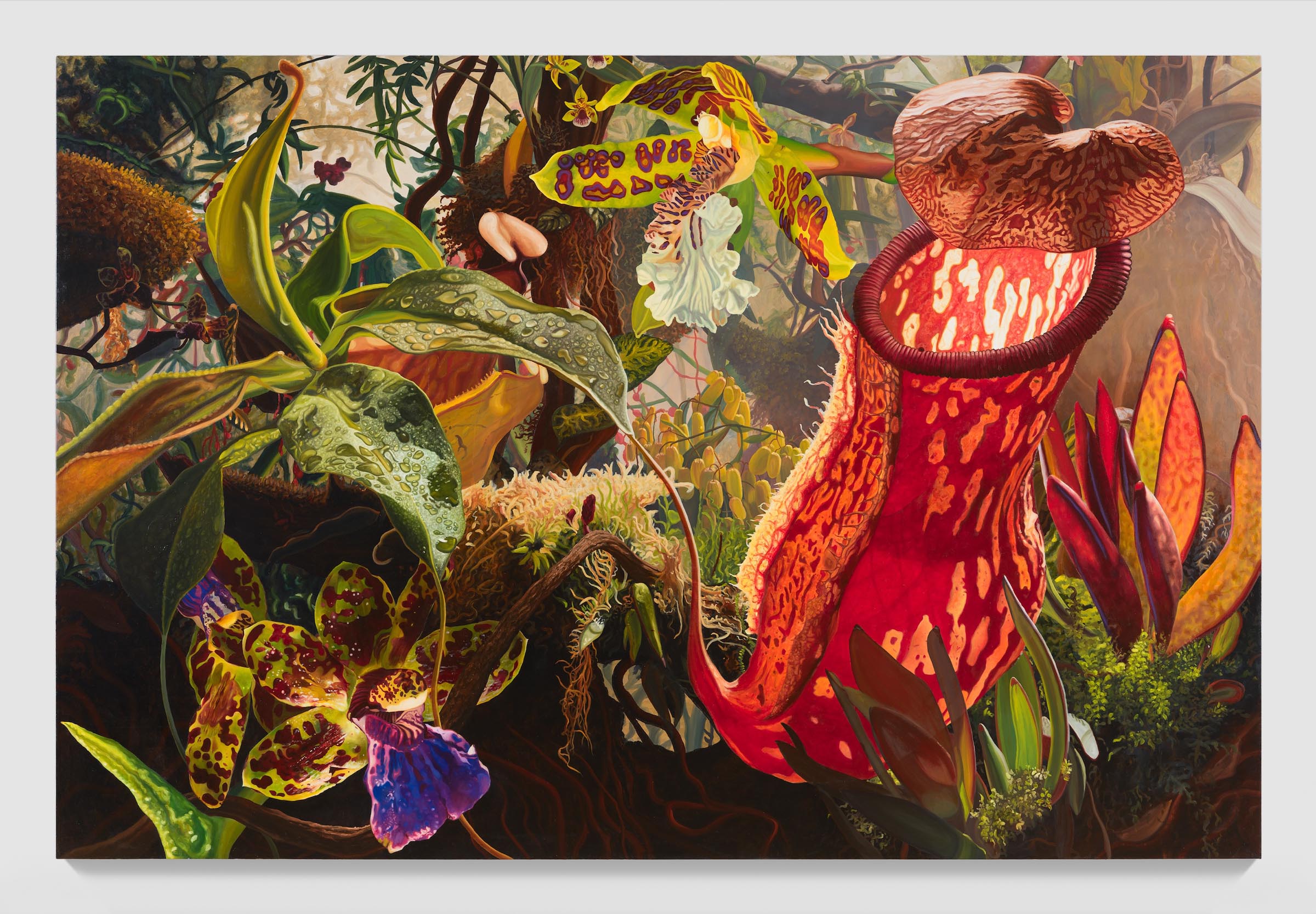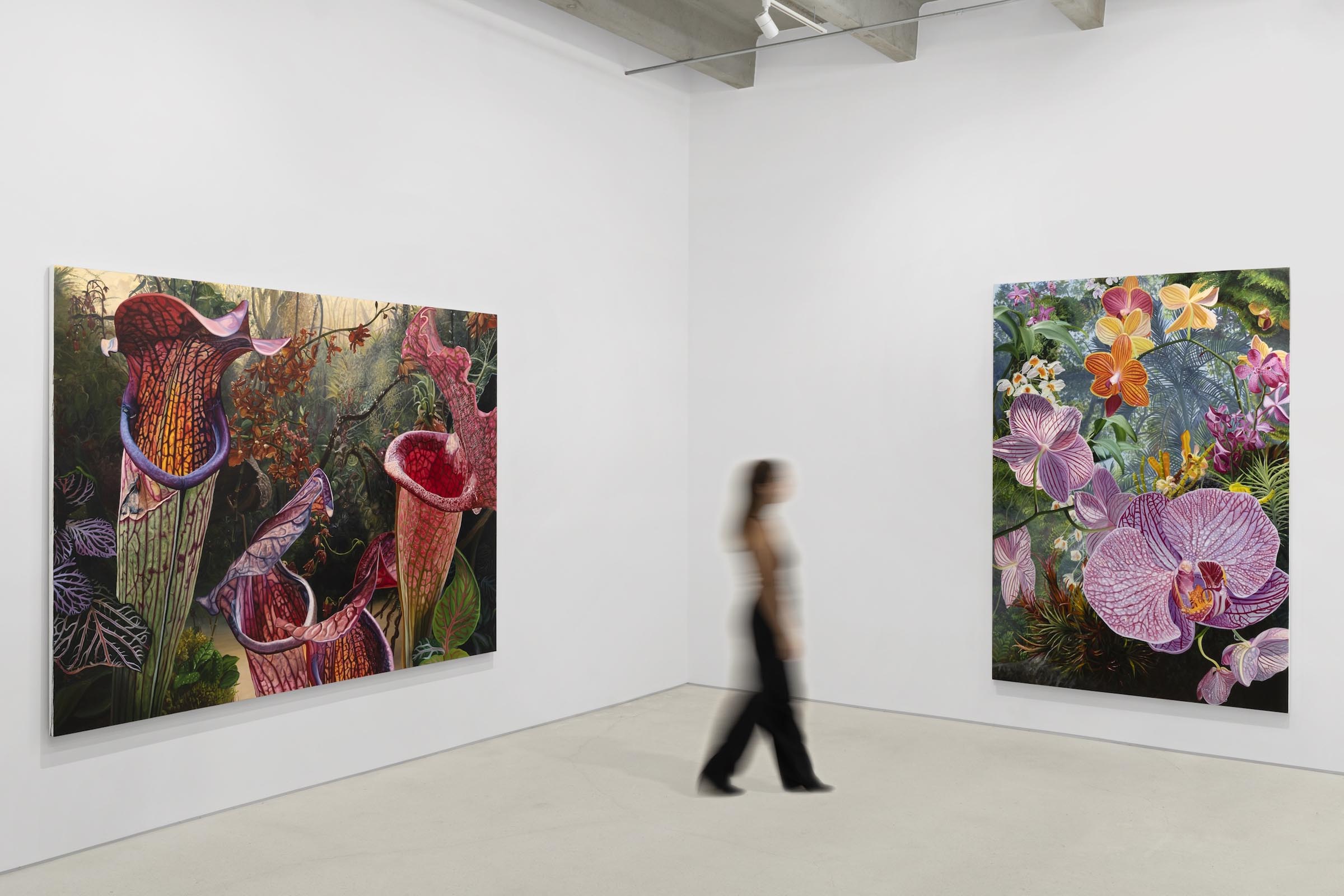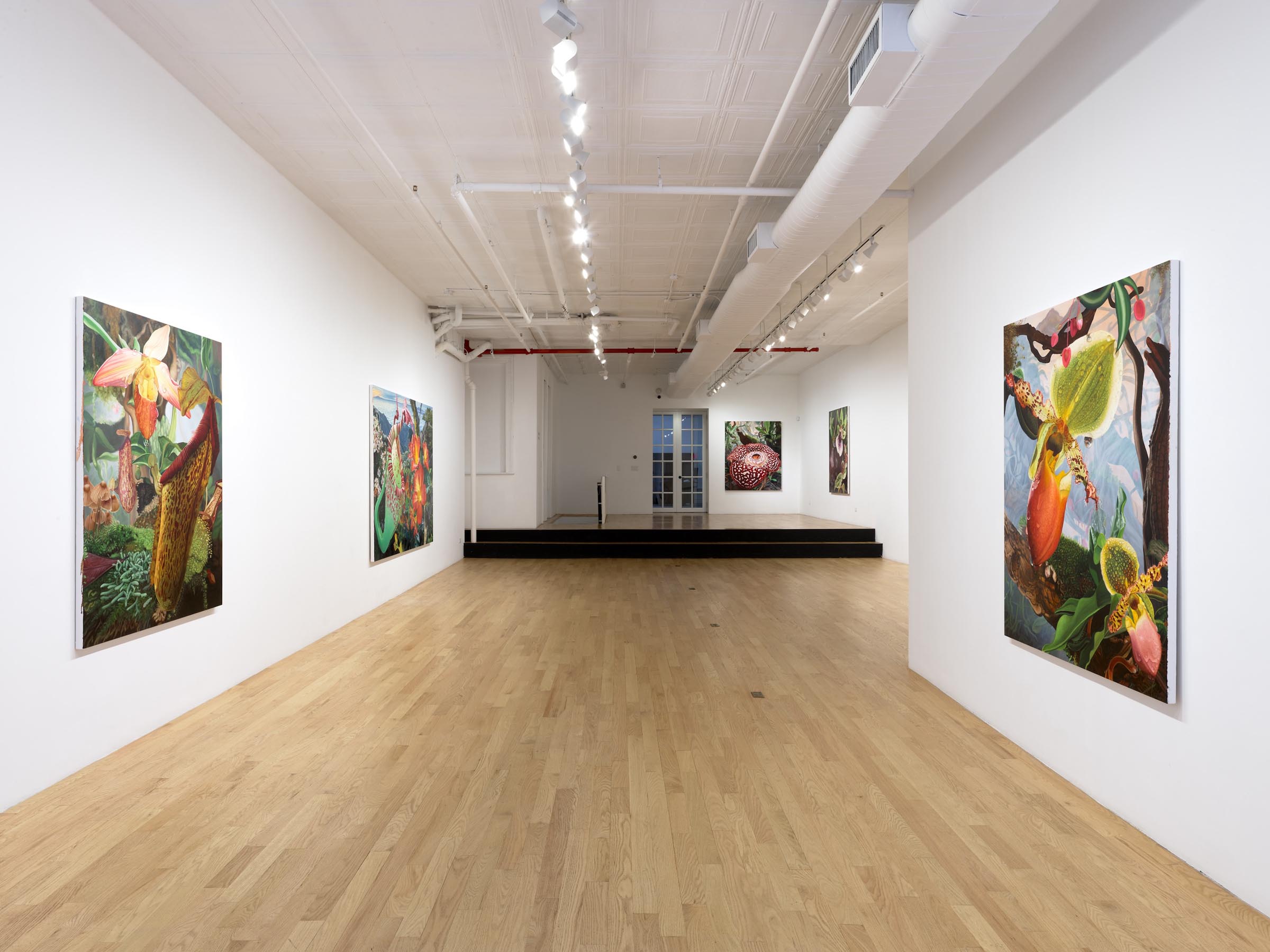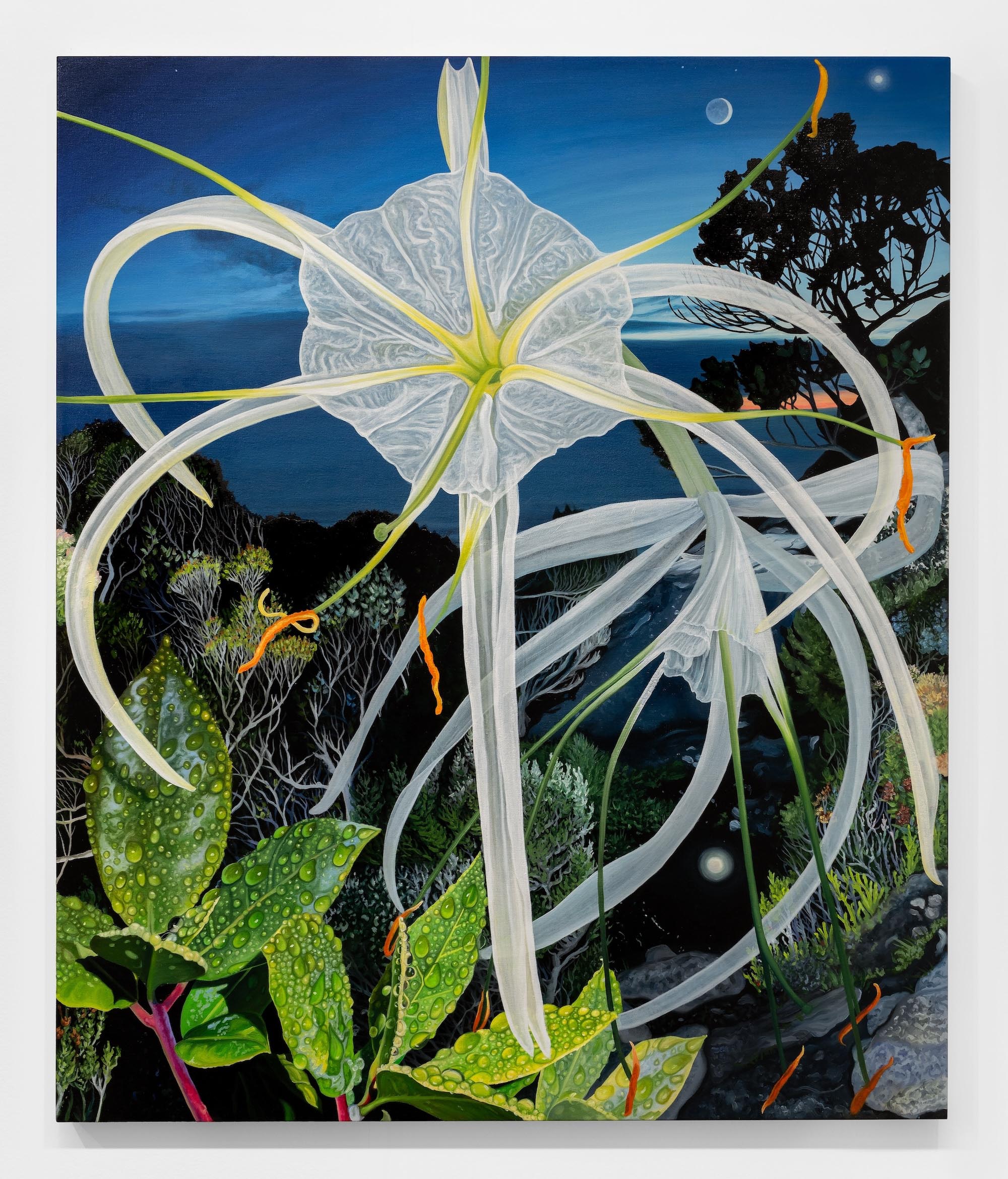Photographer based in Rockland, ME

Kate Bickmore, Portrait of the Artist. Photo by Rachel Darke
Tell us about yourself, what's your background?
I am an artist currently based in Rockland, ME, but also spend a lot of time traveling and in London, UK. I graduated from the Royal College of Art in 2019, and since then have been primairly making oil paintings of large scale flowers — or what I call 'florascapes' — that explore themes of femininity, physicality, sexuality, and spirituality based on my experience as a Highly Sensitive queer woman.
Ever since I could walk, I was wandering around my mother's garden drawing the flowers. I always knew I was meant to do something creative, but it didn't become clear to me that I was a painter until I completed my senior thesis at Hamilton College in 2015.

Hypnotic Transference of Luminous Life, 2024 oil on canvas, 72 x 108 inches (183 x 274 cm)
“I closely look to the natural world around me for inspiration and to experience awe — whether it is on my evening walk alongside Penobscot Bay, or in front of an endangered plant in a jungle in Borneo. There is so much we can learn from the botanical world, both near and far, that I feel endlessly inspired."
What are you currently working on and where did the inspiration for it come from?
I am about to start on a series of new paintings inspired by a recent trip to Socotra, Yemen. They will be presented in an exhibition at Andrew Reed Gallery in Miami, Florida, opening December 2025 during Art Basel Week.

Detail looking into ‘Her Orifices, Containing Multitudes’


(Left) Her Orifices, Containing Multitudes, 2024 Florascape Installation with Samuel Thomas (florist) and Andy White (fabricator) Pine, MDF, mirror, plexiglass, found maple knot burls, and live plants 52 x 42 x 108 inches (132 x 107 x 274 cm). (Right) Detail Inside of ‘Her Orifices, Containing Multitudes’
This new body of work will feature plants and landscapes I experienced on the unique and isolated island of Socotra (“the Galapagos of the Middle East”). There are extremely few paintings of Socotra, as it has only recently opened its borders to tourism in 2018 and allows one charter flight in and out each week from Abu Dhabi. Many parts of the island have not been explored by Westerners and the landscapes, unlike many geo-tourism locations, and are still in pristine, undisturbed condition. The works will reflect my experience of the landscape — expanding from the arid, sandy dunes, to the mossy highlands, to the surreal, alien looking trees — as well as my experience as a queer, white woman in a very conservative, Muslim country.

Sublime Intervention of Chlor-ophelia, 2024 oil on canvas, 66 x 54 inches (168 x 137cm)
I’m interested in exploring what is seen and unseen on the island — both physically and culturally. Similarly to the women, who stay mostly inside or cover with niqabs, many of the endemic plants hide deep in the landscape. We had to ride camels over a mountain, climb up and across rocky hillsides, and hike over five hours in the cold to find the bright pink Begonia socotrana growing over 30 feet away, out of the side of a cliff. Other plants, like the Adenium socotranum, were visible all over the island, and had a variety of beautiful, bulbous forms and curvy trunks, akin to the nude female form, along with showy, bright pink flowers, that unabashedly open up to the world for pollination.

Work in progress. Photo by Rachel Darke
This past month my florist Samuel Thomas and I built a diorama inspired by the rocky, arid landscape of Socotra, including plants that grew on the island, such as aloes and euphorbias, and other plants that thrive in similar environments. The purpose of the diorama was to create a miniature landscape that allows us to control lighting and composition, so I can best capture the “essence” of my experience, rather than an exact botanical replication (which would be impossible, given many of the plants in Socotra are not in cultivation).
In my last solo exhibition, I created an installation that appeared to be a fantastical, floral world existing behind a hole in the gallery wall. I would like to evolve this idea by creating two life-like sculptures of Adenium trees that will sit within my Socotra-inspired diorama. To create the bulbous organic trunk shapes I plan to experiment with pouring concrete or plaster in fabric. For the pink blooms I want to make them in glass, inspired by Harvard Museum of Natural History’s collection of Blaschka glass botanical models. This will be my first time creating representational sculpture, alongside my painting practice.

Installation shot of ‘After Rainfall' at Andrew Reed Gallery, 2023
Innovation does not only happen in the field of technology — it occurs everyday in a creative practice. What do you do for inspiration?
I closely look to the natural world around me for inspiration and to experience awe — whether it is on my evening walk alongside Penobscot Bay, or in front of an endangered plant in a jungle in Borneo. There is so much we can learn from the botanical world, both near and far, that I feel endlessly inspired. Sometimes it's too much and I get overwhlemed, which is why I like to focus on a specific place and build floral dioramas with my friend and florist Samuel Thomas. These living dioramas (i.e. gardens) include both site-specific and imagined ecological elements, that are lit and photographed for reference — allowing me to be more direct and intentional with what specific feeling and atmosphere I want to create within the paintings.

Kate Bickmore and Samuel Thomas building replicas of the Adenium socotranum tree for a diorama. Photo Credit: Lucien Pinchon

Floral diorama in progress. Photo Credit: Lucien Pinchon

Kate Bickmore and Samuel Thomas building replicas of the Adenium socotranum tree for a diorama. Photo Credit: Lucien Pinchon
Describe your practice and process. Where do ideas start for you? In the studio or being in the world?
I am endlessly exploring the surfaces, depths, and desires of my psyche and surroundings. I travel through the world in pursuit of the sublime, searching for rare and unique plants (often with help from botanists and indigenous guides), and expanding my awareness of nature’s complexities and ecologies, from which I better understand my own existence. I document my research and firsthand observations through writing, sketches, and photography with the aim to portray and preserve the wonderous plants and landscapes I encounter, and my profound appreciation for nature. With florist Samuel Thomas I create floral dioramas (i.e. gardens) inspired by these natural environments, including both site-specific and imagined ecological elements, that are atmospherically lit and photographed for reference.

Studio view


(Left) Kate Bickmore with Rafflesia bloom in Tambunan, Borneo.
(Right) Kate Bickmore next to an Adenium socotranum tree in Socotra, Yemen.
How do you make your work, does it start with a sketch?
From my extensive photo library, I digitally collage my images on an ipad to mock up the paintings' compositions, only including plants from my surrounding environments, travels, and dioramas. I create new floral narratives by weaving together references and vignettes from my life, botany, literature, ecology, art history, and mythology — merging scientific observation and Romantic philosophy that reveals nature as a unified, interconnected system. I then create intimate botanical sketches and watercolors to consider how I will translate my digital compositions to oils — capturing the individual bodily characteristics of each plant.
Many consider my painting style to be hyperrealistic, but within each painting I have some marks that are abstract, gestural, and impressionistic, as well as refined and detailed.

Studio view

Work in progress
Many artists live by their routines, what does that look like for you?
After I have my sketches for the oil paintings, I slowly and methodically build up layers of oil paint until I have created a space that appears to be both realistic and fantastic, focusing on an immersive feeling and sensory expansiveness. Throughout this process I strive to stay present — connecting to the life force that moves within myself, nature, and the painting — as both witness to and participant in its magic and revelations.


My studio rountine really changes depending on what part of the process I'm in, but I try to always start my day by journaling, meditating, doing a little cardio, and drinking a lot of water. I'm almost always listening to something while I paint, whether it's music, an audiobook, or a podcast. Recently it's been FKA twig's "EUSEXUA" and Mustafa's "Dunya". If I'm early on in the process, I aim to work from 10am-6pm, and then again after dinner late into the night when I'm closer to a deadline.

Studio view
Who are your biggest influences?
In terms of past artists, my work looks heavily to the Baroque and Rococo, Pre-Raphaelite painting, Dutch floral still lifes, the Hudson River School, as well as the work of Georgia O’Keeffe and Victorian era painter Marianne North.
I have so many favorite contemporary artists it would be hard to list them all, but I recently saw Emma Webster's work at Perrotin in Paris, and then at Petzel in NYC. I love how involved her process is in coming up with the paintings' compositions, and the painterly quality of the work is so lively and generous. I also recently saw Walton Ford's show at Gagosian — the light! The drama! He knows how to tell a great story through painting.
I would also be remissed not to mention some of the people in my life I interact with regularly that are dedicated to their practices and inspire me every day — Phoebe Dean (artist), Samuel Finkelstein (artist), Mercy Corredor (philosopher), Angelica Laboy (florist), Elysa Rose Coster (artist) + Paul Coster (writer).

Installation shot of 'On the Precipice' at Chart Gallery, 2024
Are there books or films that are an important source of inspiration?
Some books that I think about regularly in relation to my work are 'Gathering Moss' by Robin Wall Kimmerer, 'Mrs. Dalloway' by Virginia Woolf, 'The Signature of All Things' by Elizabeth Gilbert, and 'The Drowned World' by JB Ballard.
In terms of film, I really enjoy anything that exhibits a rense of magical realism or has strong female characters. My go-tos are 'The Favorite' by Yorgos Lanthimos and 'Thelma and Louise' by Ridley Scott.

Guiding Stars Defracting the Dawn, 2024 oil on canvas, 48 x 40 in (121.9 x 101.6 cm)
What is the best piece of advice you’ve been given?
The only thing that separates an artist from someone who isn't is that they keep showing up — figure out what you need to create your work. Also, it's okay to take breaks!
What is the best advice you would give to other artists?
Find the beating heat of your practice and let that propel you forward.

Portrait of the artist. Photo by Rachel Darke
Stay up to date with Kate Bickmore
Website katebickmore.com
Instagram @katebickmore